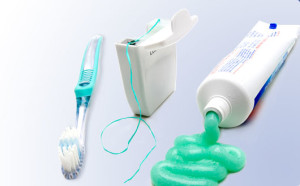Preventive Dentistry Hanover NH
Oral Exam
An oral exam is performed on both new and existing patients to determine their dental and health status. New patients receive a more comprehensive exam that includes x-rays and checks for gum and bone disease, systemic disorders and oral cancer. A more routine exam is done for existing patients to see if there have been any changes in health since their last visit. In order to look for gum disease, the gum tissue is measured with a small ruler to measure the pocket depth between the tooth and connective tissue. A measurement of over 4mm could indicate disease or infection. Gum disease can develop easier in deeper pockets due to the extent that plaque collects in these deep pockets. If the oral exam reveals the need for tooth scaling or root planing, these services are performed in lieu of or in addition to the routine cleaning.
Brushing
Proper brushing of teeth can be done in three steps:
1) Brush teeth gently using a circular motion along the outside and inside of the tooth surface while holding the brush at a 45 degree angle.
2) Make sure to brush each tooth individually and to use the front half of the brush in a circular motion vertically behind the front teeth.
3) Place the brush against the top of your teeth use a gentle back-and-forth motion to brush. After brushing all your teeth be sure to brush your tongue in order to remove odor-producing bacteria.
Flossing
Break off about 18 inches of floss and wind some of it around your middle finger (3 turns). This finger will take up the floss as it becomes dirty. Shorten the length between the two fingers to 6 inches and wind some floss (1 turn) around the opposite middle finger. Hold the floss tightly between your thumbs and index fingers.
Guide the floss between your teeth using a gentle rubbing motion. When the floss reaches the gum line, curve it into a C shape against one tooth. Gently slide it into the space between the gum and the tooth. Hold the floss tightly against the tooth as you gently rub the side of the tooth with an up and down motion. Before retrieving it, clean the adjacent tooth surface.
As you finish cleaning each contact wind the dirty floss once around the first middle finger and slide more new length of floss to proceed to the next contact.
Fluoride
Fluoride is an important part of healthy tooth development and will help prevent cavities.
Fluoride can provide protection from tooth decay in a couple ways:
1) It helps to strengthen the tooth’s enamel so it can repel the acid that is formed by plaque.
2) Teeth that have been damaged by plaque can repair and re-mineralize themselves with the help of fluoride.
Fluoride is incapable of repairing already formed cavities, but it does assist in reversing low levels of tooth decay and helps in preventing new cavities from forming.
Plaque
Plaque is essentially the start of gum disease problems. Plaque is a build-up of particles from the foods you eat every day. Once sugars are introduced to plaque, it turns into a tooth eating acid that sits just above the gum line. If regular oral care isn’t standard, the acid will start eating at the teeth and gums. Plaque that is allowed to sit for a prolonged period of time can cause cavities, gingivitis and other problems in your mouth. If it’s left longer than that, serious dental procedures may be required to restore your decaying smile.
Tooth Scaling
In order to remove plaque, tartar and calculus deposits from your teeth, a tooth scaling must occur. In some cases plaque and tartar are present below the gum line and a sub-gingival tooth scaling must occur.
Root Planing
Sometimes after a tooth scaling, the roots of a tooth must be planed in order to create a smooth surface for the gum tissue to re-attach to. In addition to the planing, your dentist may also prescribe medication in order to control infection and pain.
Sealants
Sealants are a proven way to help prevent cavities. Although sealants do not take the place of proper oral hygiene, they do prevent bacteria from getting into the deeper crevices in a tooth’s biting surface and therefore keeping the tooth cavity-free.
Summer Court Dental Office Information
Natalia Streltsov, D.M.D
Summer Court Dental
1 Summer Court
Hanover, NH 03755
Email: frontdesk@SummerCourtDental.com
Phone: 603-643-8998
Fax: 603-643-1212
Contact Summer Court Dental Today!

